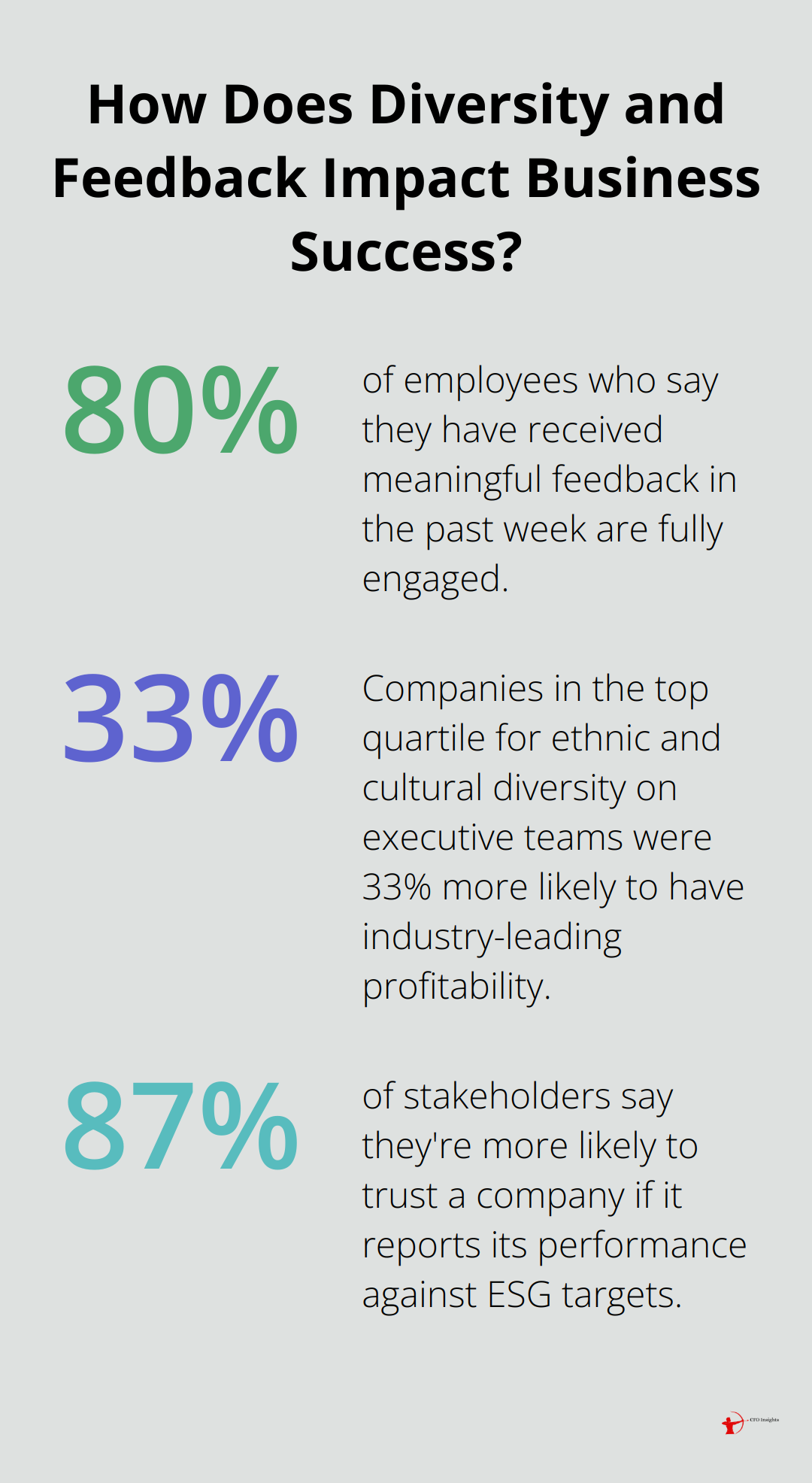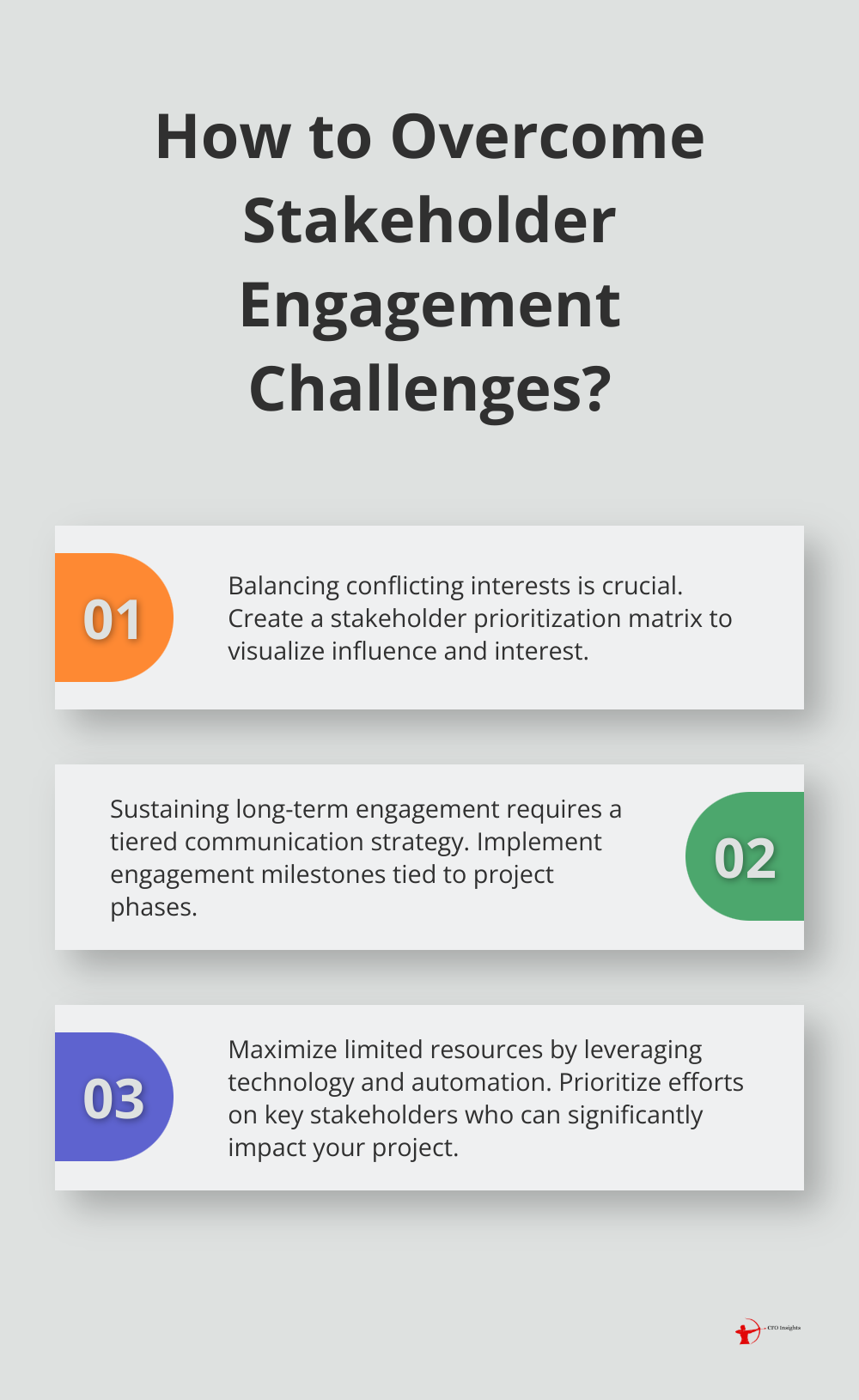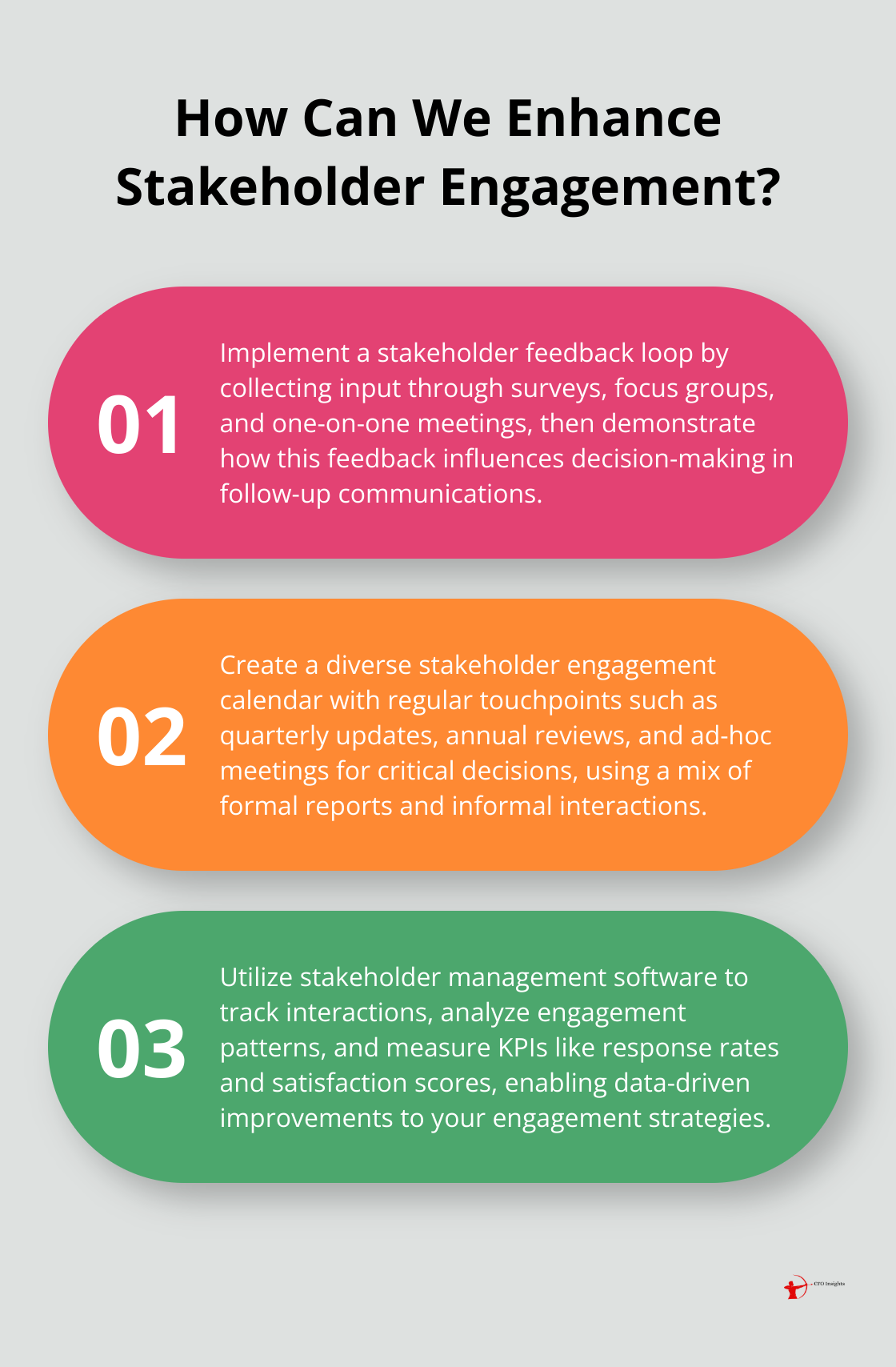Stakeholder engagement is the cornerstone of successful business operations. At CFO Insights, we’ve seen firsthand how effective stakeholder engagement communication can transform organizations.
This blog post explores the key elements that make stakeholder engagement truly impactful. We’ll also share practical strategies and solutions to common challenges, helping you build stronger relationships with your stakeholders.
What Makes Stakeholder Engagement Effective?
The Foundation of Clear Communication
Clear communication forms the bedrock of effective stakeholder engagement. It transcends mere information dissemination; it ensures your message resonates with your audience. More effective communication equals better project management.

To achieve clarity, use plain language and avoid jargon. Tailor your message to each stakeholder group, considering their expertise and interest in the project. When communicating financial data to non-financial stakeholders, use visual aids and simplified explanations to make the information more accessible.
Harnessing the Power of Active Listening
Active listening involves understanding stakeholder perspectives and concerns, not just hearing their words. Implement regular feedback mechanisms such as surveys, focus groups, and one-on-one meetings to gather insights. Gallup data shows that 80% of employees who say they have received meaningful feedback in the past week are fully engaged.
Create a stakeholder feedback loop where you collect input and demonstrate how it influences decision-making. This approach builds trust and encourages ongoing engagement. After a stakeholder engagement meeting, send a follow-up email summarizing the key points discussed and outlining the next steps based on their feedback.
Embracing Diversity in Representation
Inclusive representation ensures all relevant voices contribute to the decision-making process. A McKinsey study found that companies in the top quartile for ethnic and cultural diversity on executive teams were 33% more likely to have industry-leading profitability.
Conduct a thorough stakeholder analysis to identify all groups affected by your project or decision. Include representatives from various departments, levels of seniority, and external partners. When forming advisory boards or steering committees, try to create a diverse mix of perspectives to enrich discussions and outcomes.
Maintaining Consistent Engagement
Consistency in stakeholder interactions builds trust and maintains momentum. According to a PwC survey, 87% of stakeholders say they’re more likely to trust a company if it reports its performance against ESG targets, highlighting the importance of regular, transparent communication.
Develop a stakeholder engagement calendar that outlines regular touchpoints (e.g., quarterly updates, annual reviews, and ad-hoc meetings for critical decisions). Use a mix of communication channels – from formal reports to informal coffee chats – to keep stakeholders informed and engaged throughout the project lifecycle.
Leveraging Technology for Enhanced Engagement
In today’s digital age, technology plays a pivotal role in stakeholder engagement. Utilize stakeholder management software to track interactions, analyze engagement patterns, and provide comprehensive insights. These tools (such as CRM systems and data analytics platforms) can help you identify trends, measure engagement effectiveness, and make data-driven decisions to improve your stakeholder relationships.
As we move forward, it’s essential to consider how these key elements of effective stakeholder engagement translate into practical strategies for successful stakeholder management. Let’s explore some proven approaches that can elevate your engagement efforts to new heights.
How to Master Stakeholder Management
Create a Comprehensive Stakeholder Map
Identify all stakeholders affected by your project. This includes internal teams, external partners, customers, and regulatory bodies. Use a power-interest grid to categorize stakeholders based on their influence and interest in the project. This visual representation helps prioritize engagement efforts.

A tech startup used this method to identify a key investor they had overlooked. By engaging this stakeholder early, they secured additional funding (crucial for their product launch).
Customize Your Engagement Approach
One size doesn’t fit all in stakeholder management. Tailor your communication style and frequency to each stakeholder group. High-power, high-interest stakeholders might require weekly updates, while others may only need quarterly check-ins.
Interactions with stakeholders can involve a wide range of communication methods, from annual events to feedback surveys to email updates.
Build Trust Through Transparency
Transparency forms the foundation of trust in stakeholder relationships. Be open about project challenges, delays, and successes. When a software development project faced unexpected delays, the team immediately communicated this to stakeholders. This honesty led to increased support and understanding, ultimately contributing to the project’s success.
Implement a regular reporting schedule. Share both positive and negative updates. This consistency builds credibility and shows your commitment to open communication.
Measure and Refine Your Engagement Efforts
To improve, you must measure. Establish key performance indicators (KPIs) for stakeholder engagement. These might include response rates to communications, stakeholder satisfaction scores, or the number of issues resolved.
A retail chain implemented a quarterly stakeholder survey. This insight led to the creation of a monthly financial brief, significantly improving stakeholder satisfaction.
Use stakeholder management software to track interactions and analyze engagement patterns. This data-driven approach allows for continuous improvement of your engagement strategies.
Leverage Technology for Enhanced Engagement
In today’s digital age, technology plays a pivotal role in stakeholder engagement. Utilize stakeholder management software to track interactions, analyze engagement patterns, and provide comprehensive insights. These tools can help you identify trends, measure engagement effectiveness, and make data-driven decisions to improve your stakeholder relationships.
Effective stakeholder management requires ongoing attention and adaptation. As we move forward, we’ll explore common challenges in stakeholder engagement and provide practical solutions to overcome them.
Navigating Stakeholder Engagement Hurdles
Balancing Conflicting Interests
Stakeholders often have competing priorities. A manufacturing company faced this when shareholders pushed for cost-cutting while employees advocated for better benefits. The solution? Create a stakeholder prioritization matrix. This tool helps you visualize each group’s influence and interest, allowing you to make informed decisions about resource allocation.

We recommend holding separate meetings with conflicting groups before bringing them together. This approach allows you to understand individual concerns and find potential common ground. In the manufacturing case, we identified shared interests in long-term company growth, which became the foundation for a compromise.
Sustaining Long-term Engagement
Keeping stakeholders invested over time is essential. To combat this, implement a tiered communication strategy. High-priority stakeholders receive frequent, detailed updates, while others get periodic summaries.
Create engagement milestones tied to project phases. For instance, a tech startup scheduled major product demos to coincide with key development stages, maintaining investor interest throughout the year-long development cycle.
Maximizing Limited Resources
Resource constraints often hinder effective stakeholder management. A small non-profit struggled to manage relationships with donors, volunteers, and beneficiaries due to limited staff. The solution? Leverage technology and automation.
Implement a Customer Relationship Management (CRM) system to track interactions and automate routine communications. The non-profit used this approach to send personalized thank-you notes to donors and regular updates to volunteers, increasing engagement without straining their small team.
Prioritize your efforts. Focus on the stakeholders who can make or break your project. For others, consider group communications or less frequent touchpoints to manage resources effectively.
Bridging Cultural and Language Gaps
In our increasingly global business environment, cultural and language barriers can significantly impact stakeholder engagement. A U.S.-based company expanding into Asia faced this challenge when communicating with local partners.
Invest in cultural training for your team. Understanding local customs and communication styles can prevent misunderstandings and build stronger relationships. Consider hiring local liaisons or consultants who understand both cultures to facilitate communication.
Use visual aids and simple language in your communications. Infographics, charts, and videos can convey complex information across language barriers. When working with the Asian partners, our client created bilingual presentations with clear visuals (significantly improving understanding and engagement).
Final Thoughts
Effective stakeholder engagement communication forms the foundation of successful project management and organizational growth. Clear communication, active listening, inclusive representation, and consistent interactions create impactful stakeholder relationships. These elements, combined with strategic approaches like comprehensive stakeholder mapping and tailored engagement strategies, establish a robust framework for stakeholder management.

The journey to excellent stakeholder engagement requires continuous improvement and adaptability. Organizations must overcome common hurdles such as conflicting interests, maintaining long-term engagement, and resource constraints. Implementing solutions like stakeholder prioritization matrices, tiered communication strategies, and leveraging technology can significantly enhance engagement efforts.
Effective stakeholder management leads to improved decision-making, increased support for initiatives, and better project outcomes. We at CFO Insights specialize in providing fractional CFO services that help organizations optimize their finance teams’ performance and value. For more insights on financial leadership and strategy, visit our CFO Insights blog.




